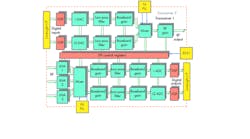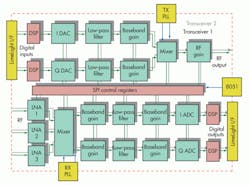Lime Microsystems’ LMS7002M field programmable RF transceiver targets a wide range of wireless applications, especially those using 2x2 multiple-input multiple-output (MIMO). Made with 65-nm CMOS, this dual-transceiver chip supports all cellular standards and frequencies including 2G, 3G, and 4G/LTE with both time-division duplex (TDD) and frequency-division duplex (FDD) variants.
This file type includes high resolution graphics and schematics when applicapable.
Also, the LMS7002M can implement any flavor of Wi-Fi as well as any other wireless standard like WiMAX. Other potential applications include machine-to-machine (M2M) communications, any software-defined radio (SDR), small cells, white space radios, tablets, netbooks, and laptops.
The baseband inputs and outputs are via a differential parallel interface compatible with the JESD207 standard (see the figure). There are two separate signal chains for both transmit and receive. The transmit and receive phase-locked loop (PLL) synthesizers are on chip with all of the 12-bit analog-to-digital converters (ADCs) and digital-to-analog converters (DACs). The useable frequency range is from 50 MHz to 3.8 GHz. The modulation bandwidth is fully programmable from 1.5 MHz to 28 MHz.
Each of the receiver’s three low-noise amplifier (LNA) inputs can be tuned separately to different bands. The receiver also features automatic gain control (AGC) and received signal strength indicator (RSSI) circuitry. The transmitter output is +3-dBm continuous wave, which is sufficient to drive an external power amplifier (PA) as may be required.
The chip is programmed by way of a serial peripheral interface (SPI). On-chip registers store the program parameters. An integrated 8051 microcontroller manages the programming of most of the internal circuits and simplifies calibration and setup. The chip may be reprogrammed on the fly.
A single 1.8-V dc power source operates the transceiver. Interestingly, individual circuit blocks may be powered down to save power if it’s not used. Standby current is less than 1 mA. The device is housed in an 11.5- by 11.5-mm, quad flat no-lead (QFN) package.
The LMS7002M is a dual and enhanced version of Lime’s successful LMS6002D single-stream transceiver. Both products replace multiple chips in new wireless products, making RF design easier than ever. For more details and pricing, contact Lime directly.
Lime Microsystems


